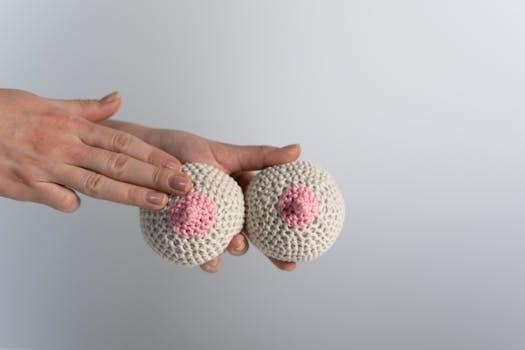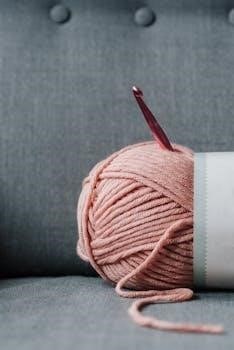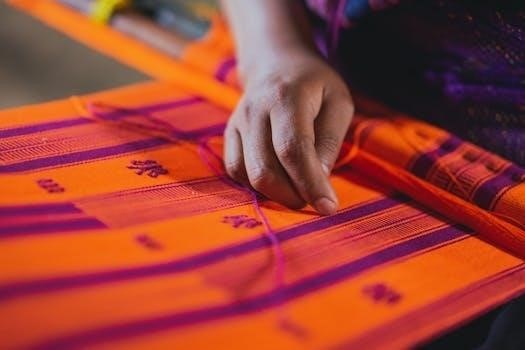This guide explores the world of yarn, covering its diverse types and uses. From fiber content to weight, understanding yarn is key for crafting. Whether knitting or crocheting, this knowledge will enhance your projects.
Understanding Yarn’s Importance
Yarn is the foundational element in countless textile crafts, from knitting and crochet to weaving and more. Its importance extends beyond mere material; it dictates the texture, drape, and overall feel of a finished product. The right yarn can transform a simple project into a cherished item, while the wrong choice might lead to frustration. Understanding yarn types, weights, and fiber content allows crafters to select appropriate materials for specific projects. This knowledge ensures not only the desired aesthetic outcome but also the functionality and longevity of the creation. Whether working with natural or synthetic fibers, a deep understanding of yarn is essential for any textile enthusiast.
Overview of Yarn Types
Yarn types are incredibly diverse, categorized by their fiber composition and construction. Natural fibers like wool, cotton, and silk offer unique qualities, while synthetic options such as acrylic, nylon, and rayon provide alternatives with different benefits. Additionally, blended yarns combine various fibers to achieve specific textures and properties. Yarn weight, ranging from lace to bulky, determines the thickness of the strand, impacting the final project’s gauge and appearance. Specialty yarns, like bouclé and stretch yarns, add dimension and functionality. Understanding these diverse characteristics is crucial for selecting the appropriate yarn for any given project, ensuring the desired outcome.

Yarn Fiber Categories
Yarn fibers are broadly classified into natural and synthetic groups. Natural fibers include animal-based and plant-based sources. Synthetic fibers are man-made, each with unique characteristics and applications.
Natural Fibers⁚ Animal-Based
Animal-based natural fibers are a popular choice for yarn, offering warmth and unique textures. Wool, sourced from sheep, is a classic example, known for its versatility and insulating properties. Cashmere, from goats, is prized for its luxurious softness. Alpaca and llama fibers provide a soft, durable alternative, often with a silky feel. Mohair, obtained from Angora goats, adds a fluffy, halo-like effect to projects. Angora, from rabbits, is exceptionally soft and delicate, requiring gentle handling. These fibers, while varying in their specific qualities, share a common origin from animals and are used in a wide range of applications, from clothing to home goods, providing diverse options for crafters.
Natural Fibers⁚ Plant-Based
Plant-based natural fibers offer a wide range of textures and properties for yarn. Cotton, derived from the cotton plant, is widely used for its affordability, breathability, and strength, making it ideal for warm-weather garments and household items. Linen, from flax plants, is known for its durability and crisp feel, often used in summer clothing and home textiles. Hemp, another plant fiber, is gaining popularity for its strength and eco-friendly qualities. Bamboo, a sustainable option, is soft and absorbent, suitable for various projects. These plant-based fibers provide a diverse range of options, from lightweight summer wear to durable accessories, each with its unique characteristics and uses.
Synthetic Fibers
Synthetic fibers are man-made materials offering unique properties in yarn. Rayon, a semi-synthetic fiber, is known for its silky texture and drape. Acrylic is a popular, affordable option that is often used as a wool substitute. Nylon, a strong and elastic fiber, is used in many blends for its durability. Polyester, another common synthetic, is wrinkle-resistant and often mixed with other fibers. These synthetic fibers offer benefits such as affordability, durability, and easy care. They are used to create a variety of yarn types and are often blended with natural fibers to enhance specific characteristics, catering to various crafting needs.

Yarn Weights and Their Uses
Yarn weight refers to the thickness of the strand, influencing project outcomes. Understanding weight categories is crucial for selecting the right yarn for your specific crafting needs.
Yarn Weight Categories Explained
Yarn weight is categorized into a numerical system, often accompanied by descriptive terms. These categories range from the finest, like lace weight, to the bulkiest, such as jumbo. The Craft Yarn Council provides standardized symbols for each weight. Understanding these categories is crucial for successful projects. Lighter weights are ideal for delicate items, while heavier weights are suitable for quick-to-make projects. A worsted weight yarn, for instance, falls into the medium category. Bulky weight yarns include chunky, a lighter variant of the category. Knowing these distinctions helps crafters choose the appropriate yarn for their desired outcome and pattern requirements, ensuring the intended drape and texture is achieved.
Common Uses for Different Weights
Different yarn weights are suited for specific projects. Fine, lace-weight yarns are perfect for delicate shawls and intricate lace work. Sport weight yarns are excellent for baby clothes and lightweight garments. Worsted weight, a popular medium weight, is versatile for blankets, sweaters, and hats. Bulky yarns, including chunky varieties, work well for quick projects like cozy blankets, scarves, and hats. Jumbo weight yarn is often used for arm-knitting projects, creating chunky blankets and throws. Each weight offers unique characteristics, influencing the final fabric’s drape and texture. The appropriate weight choice ensures the desired effect for each craft. Selecting the right yarn weight is essential for project success.

Specialty and Novelty Yarns
Specialty yarns offer unique textures and appearances. These include bouclé yarns with loops, and tube yarns suitable for trivets. They add creative flair to projects, creating distinct fabrics.
Textured Yarns
Textured yarns are a fascinating category within the world of specialty yarns, offering a wide array of tactile and visual effects. These yarns are crafted with unique structures that go beyond the smooth, even surface of traditional yarns. A prominent example is bouclé yarn, characterized by its loops and curls which create a bumpy, textured fabric. These loops can be small and tight or larger and looser, resulting in a variety of textural outcomes. This type of yarn is fantastic for adding dimension and visual interest to projects, making it perfect for garments, accessories, and home decor items that need that extra something. The variety of textures available in this category makes them a popular choice for crafters seeking to add unique elements to their creations.
Stretch Yarns
Stretch yarns are essential for creating fabrics that require flexibility and give, such as stretch denim and stretch lace. The degree of stretch in a fabric is determined both by the type of yarn used and the construction of the fabric itself. When yarn is interlooped, as in knitting, it naturally produces a stretchier fabric. However, woven fabrics generally exhibit less stretch. There are various types of stretch yarns available, each designed to provide different levels of elasticity. These yarns are crucial for garments that need to move with the body, offering comfort and a better fit. This category allows crafters to explore the functionality of yarn and its impact on the final product.

Choosing the Right Yarn
Selecting the perfect yarn involves considering various factors. This section will guide you through making informed choices, ensuring your projects meet your vision and needs.
Factors to Consider
When selecting yarn, several factors come into play. First, consider the fiber content⁚ natural options like cotton, wool, and silk offer different textures and properties compared to synthetics like acrylic or nylon. The project type also dictates yarn choice; a delicate shawl requires a different yarn than a sturdy bag. Think about the yarn’s weight, which affects the fabric’s drape and density. Furthermore, consider the color and texture to match your design. Allergies and washability are practical concerns that influence your final decision. By carefully evaluating these aspects, you can choose the right yarn for a successful project that meets both your creative vision and functional needs, ensuring a satisfying crafting experience. Finally, consider the overall feel you are trying to achieve.
Best Practices for Selection
When selecting yarn, always begin by identifying your project’s needs. Consult patterns closely, noting recommended yarn weights and fiber types. If substituting, match weights and consider the intended drape and texture. Always check the dye lots to ensure consistent color throughout your project. Feel the yarn; its softness and texture can impact your crafting experience. Read yarn labels for care instructions and fiber content. It is wise to swatch with your chosen yarn to check gauge. Buy extra to avoid running out mid-project or if you need to make any alterations. Finally, store your yarn correctly to maintain its quality. Don’t be afraid to experiment with different yarns to discover new favorites. These practices will help achieve optimal results.